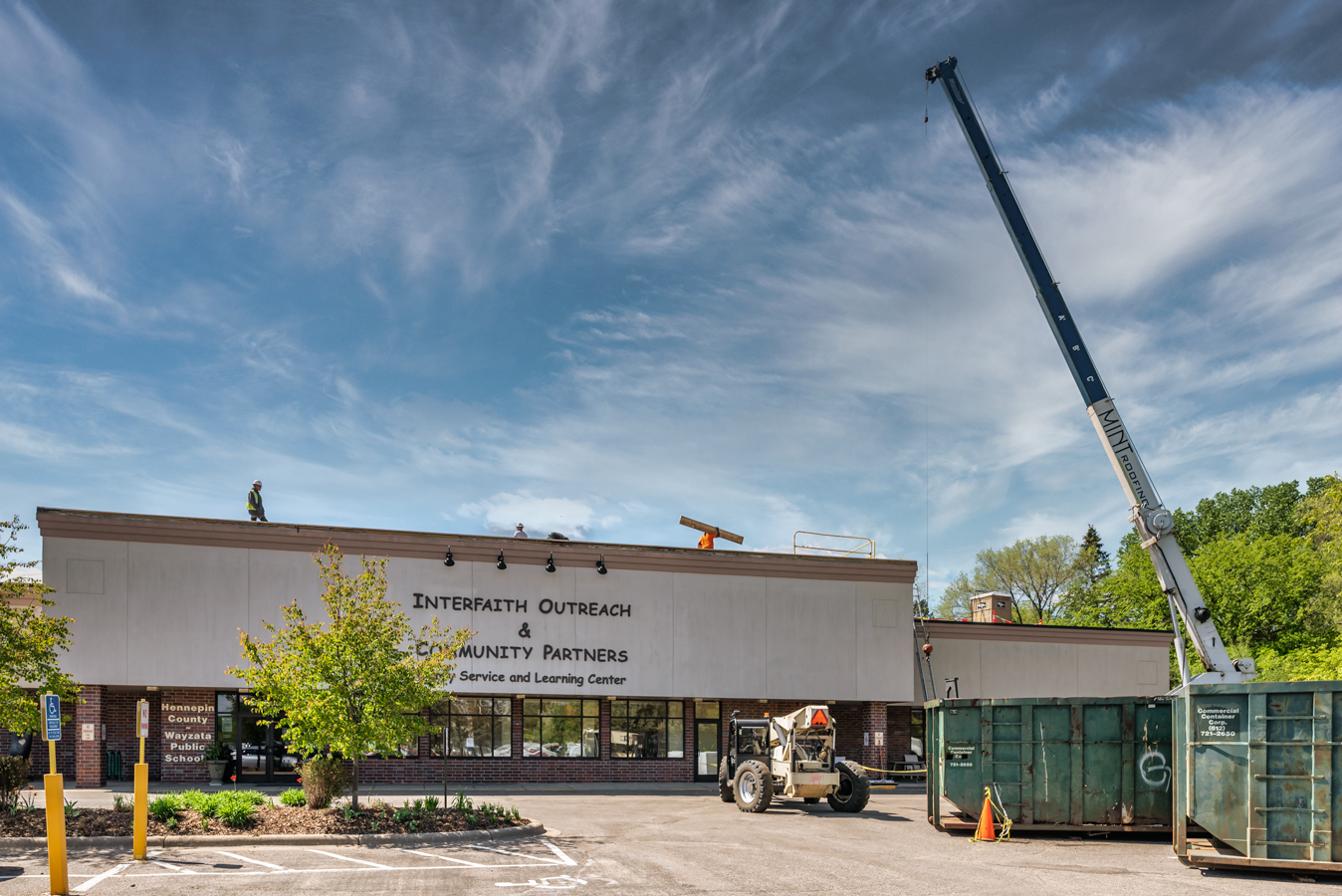Phase I: Inspection, Planning, and Estimating
The first phase of a flat commercial roof replacement is the inspection and planning stage. This is when your commercial roofing contractor will assess your roof and its current condition, determine what needs to be done, and develop a plan of action.
INTERIOR INSPECTION
The first thing a commercial roofing contractor will do is inspect the interior of the structure, since this is where the most damage can be found. If structural damage to the inside areas has compromised their integrity, it must be repaired as part of the procedure.
Water damage is detected by looking for indications such as discoloration in the walls and mold accumulating in dark, damp areas in the building. The inspection crew will look for tears in the roofing that expose the interior spaces to the outside elements.
The majority of the interior examination will be done visually or with basic equipment like a flashlight. The contractor will also want to go up in any higher storage areas beneath the roof to look for internal damage.
In general, the internal inspection procedure is straightforward and painless. However, the length of time it takes may differ significantly based on the size of your business facility.
EXTERIOR INSPECTION
After that, contractors will inspect the roofing system from the outside. Getting up on the roof and closely examining the entire roofing system is an essential part of this process phase.
Visual indicators of damage that your roofing contractor will be looking for include single-membrane roof structure impact damage, damaged flashing, old and worn-out caulk, and visible signs of roof leaks and damage to the drainage system.
COST ESTIMATING
After your roof has been inspected inside and out, your roofing contractor will prepare a quote for the job. This estimate will include most or all of the following:
- Material Cost
- Labor Cost
- Inspection Report
- Scope of Work (SOW)
- Project Timeline
- Contract with Terms and Conditions
Phase II: Flat Commercial Roof Replacement – Pre-Production
During this phase, your roofing contractor’s project coordinator will take care of any necessary permits or approvals from your local government. The planning phase can take anywhere from a week to a month. Various factors impact the planning phase, from confirming architectural details to pulling the necessary permits.
Phase III: Demolition and Prep
Once the planning is complete, it’s time for demolition. The old roof material will be removed, and any damaged decking or structural elements will be repaired or replaced. This phase can be messy and disruptive, so be sure to communicate with your tenants or employees about expectations ahead of time.
Your commercial roofing contractor will need to place large dumpsters in the parking lot or somewhere on the building grounds. A large crane will be brought in to aid in the removal of the old roof material and lift the equipment and new materials needed in the installation phase.
Due to the hazards of the heavy equipment and moving of materials, the area surrounding the equipment on the ground will be roped off, and hard hats will be required for anyone inside the work perimeter. New roofing materials are also delivered and staged on the ground until the demolition phase is complete.
It’s important to have an alternative parking plan in place for tenants, occupants, employees, and customers before the beginning of demolition.
Once started, this phase can take anywhere from a day to a week or more, depending on the size and construction of the building.
Phase IV: Installation
The next phase is installation, when the new roof system is put in place. This includes installing the new membrane, flashings, and drainage systems. Once everything is in place, the contractor will finish up by putting on the new gravel or stone ballast if required.
This stage usually takes a few days or more to complete, but installation timelines differ based on the type of product. Rainy weather can delay the project during installation, so crews try to plan for good weather windows to schedule installation.
Phase V: Post-Installation Inspection and Clean-up
The final phase is the post-installation inspection. This is when the contractor will check to ensure that everything was installed correctly and that there are no leaks or other issues. Local inspectors will perform an on-site inspection and sign off on the completed project. The manufactrer’s technical representative will provide you with a warranty for your new roof system.
Once the permits have been closed out, the site will be cleaned up, and all remaining equipment and materials will be cleared from the property.
Weather
Weather can disrupt even the best planning. Spring and summer storms can cause delays, especially during the installation phase, so it’s important to be patient and flexible during this process.
Your commercial roofing contractor will pay close attention to weather forecasts and may speed up or slow down a project to accommodate weather patterns.
Conclusion
Having a commercial roof replaced can be a big project, but it’s important to know what to expect. By understanding the different phases of work, you can be prepared for what’s ahead. With a bit of planning, your roof replacement will go smoothly, and you’ll have a brand new roof that will protect your property for years to come.
If you have any questions about commercial roof replacements or need to discuss your commercial roofing needs, please contact Mint Roofing at 952-473-8080. We’re always happy to help!
FAQs
Q: How do I know if my flat commercial roof needs replacement?
A: There are several signs that indicate the need for a flat commercial roof replacement. These include water leaks, extensive damage or deterioration, frequent repairs, mold or mildew growth, and sagging areas. It is advisable to consult a professional roofing contractor to assess the condition of your roof and determine if replacement is necessary.
Q: How long does a flat commercial roof replacement take?
A: The duration of a flat commercial roof replacement depends on various factors, such as the size and complexity of the roof, weather conditions, and the specific materials being used. On average, it can take anywhere from a few days to a few weeks to complete a flat commercial roof replacement project. It is best to consult with your roofing contractor for a more accurate estimate based on your specific circumstances.
Q: What are the benefits of replacing my flat commercial roof?
A: Replacing your flat commercial roof offers several benefits. Firstly, it improves the overall structural integrity of your building, enhancing its safety and longevity. A new roof also provides better protection against water leaks and weather damage, reducing the risk of costly repairs and potential business disruptions. Additionally, a new roof can improve energy efficiency, lower utility costs, and enhance the aesthetic appeal of your property.
Q: How much does a flat commercial roof replacement cost?
A: The cost of a flat commercial roof replacement varies depending on several factors, including the size of the roof, the type of materials used, the complexity of the project, and any additional features or requirements. It is recommended to request quotes from multiple reputable roofing contractors to get a better understanding of the cost range for your specific needs.
Q: What should I consider when choosing a roofing contractor for my flat commercial roof replacement?
A: When selecting a roofing contractor for your flat commercial roof replacement, it is essential to consider their experience, reputation, and credentials. Look for contractors who have a proven track record in commercial roofing, proper licensing and insurance, and positive customer reviews. It is also beneficial to inquire about warranties, the types of materials they use, and their project timeline to ensure they can meet your specific requirements.



